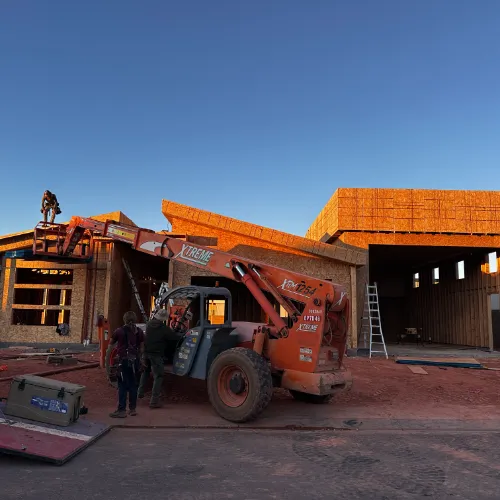When planning a construction project (whether it’s a new home, an addition, or a commercial build) one of the first questions that comes up is cost. Every stage of construction carries its own expenses, but one of the most important to understand is framing.
Framing is the backbone of the building. It defines the structure, supports the weight of the roof, and shapes the rooms where life will happen. But how much does framing cost, and what factors influence the price?
In this article, we’ll break down the average cost of framing, the key factors that affect it, and what both homeowners and contractors should know to budget wisely.
What Does Framing Include?
Before talking numbers, it’s important to understand what framing typically covers. Framing costs generally include:
- Labor: Skilled framers assembling walls, floors, ceilings, and roofs.
- Materials: Lumber or steel studs, beams, joists, trusses, and sheathing.
- Hardware: Nails, screws, hangers, and fasteners.
- Equipment: Tools and sometimes lifts or scaffolding for larger projects.
It’s worth noting that finishing elements like drywall, insulation, and siding are not part of framing costs as those come later in the build.
Average Cost of Framing a House
The cost of framing is usually measured in two ways: by square foot or by total project cost.
- National Average (U.S.): $7–$16 per square foot of living space.
- Typical Home: For a 2,000-square-foot house, framing alone can range from $14,000 to $32,000.
These numbers are averages. Costs may be lower in some regions and higher in others, especially where labor or material prices fluctuate.
Key Factors That Affect Framing Costs
Several variables can influence the final price tag. Let’s look at the main ones:
1. Size of the Project
The bigger the house or building, the higher the cost. A simple one-story home will require fewer materials and less labor than a multi-story house with complex layouts.
2. Type of Materials
- Wood Framing: The most common and generally less expensive option. Lumber prices, however, can fluctuate based on market demand.
- Steel Framing: Stronger and more durable, but usually 10–20% more expensive upfront than wood.
- Hybrid Systems: Using both wood and steel can help balance cost and durability.
3. Design Complexity
Straightforward rectangular layouts cost less to frame than homes with vaulted ceilings, open-concept floor plans, angled walls, or custom rooflines. Complexity requires more time, skill, and materials.
4. Labor Rates
Labor costs vary by region. In high-demand areas or large metropolitan cities, labor can be significantly more expensive than in rural areas.
5. Location and Access
- Remote or hard-to-access lots may increase costs.
- Projects in areas with extreme weather may require extra precautions that slow down framing.
6. Additional Features
Framing for extras like large windows, decks, basements, or garages adds to the overall cost.
Cost Breakdown: Wood vs. Steel
Wood Framing Costs
- Material Costs: $3–$6 per square foot.
- Labor Costs: $4–$10 per square foot.
- Best For: Most residential projects where cost and speed are priorities.
Steel Framing Costs
- Material Costs: $5–$10 per square foot.
- Labor Costs: $5–$12 per square foot (requires specialized crews).
- Best For: Large-scale builds, multi-family projects, and areas with termite, moisture, or fire concerns.
Additional Expenses to Consider
Beyond the basics, here are some extra costs that may factor into a framing budget:
- Trusses and Roof Systems: Prefabricated trusses cost more upfront but can save labor time.
- Sheathing: Adding plywood or OSB panels to walls and roofs typically adds $2–$5 per square foot.
- Inspections: Local building codes require inspections during and after framing, which may come with fees.
- Waste Removal: Disposal of scrap lumber or steel may add minor costs.
How to Save on Framing Costs
Framing is not the place to cut corners, but there are smart ways to save money without sacrificing quality:
- Plan Ahead: Detailed blueprints reduce mistakes and rework.
- Choose Efficient Designs: Simpler floor plans with fewer angles and custom features cost less to frame.
- Buy Materials in Bulk: Contractors often save money by purchasing lumber or steel in larger quantities.
- Use Prefabricated Components: Pre-built trusses or panelized walls can reduce on-site labor costs.
- Hire Experienced Framers: Skilled crews may cost more upfront but save money by working faster and preventing errors.
The Risk of Choosing the Cheapest Option
It can be tempting to choose the lowest bid, but framing is one stage where quality matters most. Poorly executed framing can lead to:
- Uneven walls and floors.
- Structural issues requiring expensive repairs.
- Delays for other trades like plumbers and electricians.
- Long-term durability problems.
Investing in a reliable, experienced framing crew ensures the rest of the project goes smoothly.
Budgeting for Framing in the Overall Build
Framing is just one portion of a construction budget, but it’s a significant one. Typically, framing accounts for 10–20% of the total cost of building a home.
For example:
- A $250,000 home might include $25,000–$50,000 in framing costs.
- A $500,000 home could carry $50,000–$100,000 in framing expenses.
Understanding this percentage helps homeowners and contractors allocate funds appropriately.
To Wrap Things Up
So, how much does framing cost? For most residential homes, you can expect to pay $7–$16 per square foot, or $14,000–$32,000 for a 2,000-square-foot house. Larger, more complex, or steel-framed projects can go higher.
The exact price will depend on the size, design, materials, labor rates, and location of your project. But no matter the cost, one thing remains true: quality framing is worth every penny.
It’s the stage that determines the strength, accuracy, and longevity of the entire build. By investing in skilled framers and planning wisely, you set the foundation for a project that’s safe, beautiful, and built to last.
